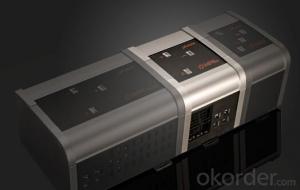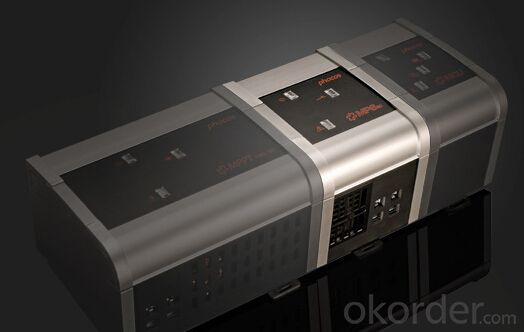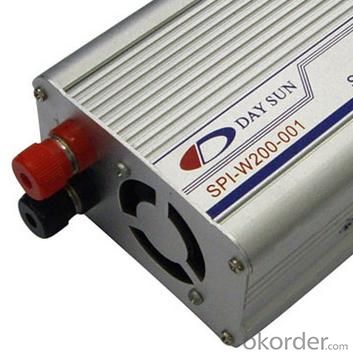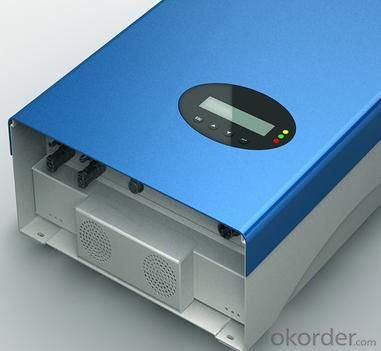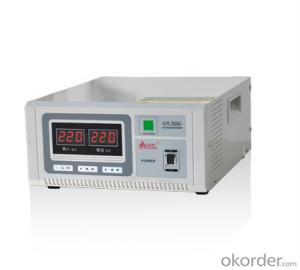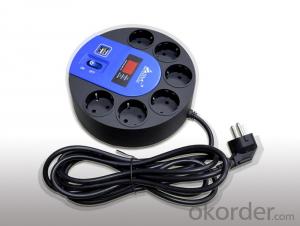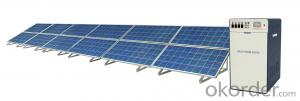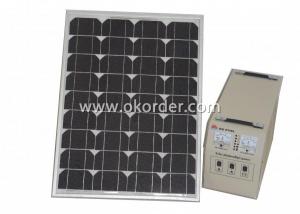Solar Phocos AG MPS (45 – 80 A) Modular Power Switch High Quality for Solar Energy Systems in Alaska
- Loading Port:
- China Main Port
- Payment Terms:
- TT or LC
- Min Order Qty:
- -
- Supply Capability:
- 10000 unit/month
OKorder Service Pledge
OKorder Financial Service
You Might Also Like
1, Product desciption
Inverter circuits designed to produce a variable output voltage range are often used within motor speed controllers.
The DC power for the inverter section can be derived from a normal AC wall outlet or some other source. Control and feedback circuitry is used to adjust the final output of the inverter section which will ultimately determine the speed of the motor operating under its mechanical load.
Motor speed control needs are numerous and include things like: industrial motor driven equipment, electric vehicles, rail transport systems, and power tools. (See related: variable-frequency drive ) Switching states are developed for positive, negative and zero voltages as per the patterns given in the switching Table.
The generated gate pulses are given to each switch in accordance with the developed pattern and thus the output is obtained.
2, Features of the product
Inverters convert low frequency main AC power to higher frequency for use in induction heating.
To do this, AC power is first rectified to provide DC power. The inverter then changes the DC power to high frequency AC power. Due to the reduction in the number of DC Sources employed, the structure becomes more reliable and the output voltage has higher resolution due to an increase in the number of steps so that the reference sinusoidal voltage can be better achieved.
This configuration has recently become very popular in AC power supply and adjustable speed drive applications. This new inverter can avoid extra clamping diodes or voltage balancing capacitors. There are three kinds of level shifted modulation techniques, namely:
· Built-in 1 year data logger for system analysis
· Charge and discharge status display
· Acoustic load disconnect pre-warning
· Load status indication
· Choose between 5 load disconnect algorithms
· Boost/absorption/float PWM-regulation (series type)
· Integrated temperature compensation
· Covered terminals (up to 16 mm2 wire size)
· Full solid-state protection
The first thing to figure out is the length of road in need of street lights.
This can be a small entrance road only a couple hundred of feet long to miles of streets through an area. Does the area currently have any type of lighting available.
What is the reason for needing street lights in this area
Is the electrical grid already nearby or would you need to call in the power company to bring in electrical lines.
If the electric needs to be brought to the area, how much is this going to cost? Depending on how far the grid electric is from the location of the needed lighting, this can be quite expensive.Solar power is energy from the sun. "Solar" is the Latin word for "sun" and
And Powerful source of energy. Without it, there will be no life.
Solar energy is considered as a serious source of energy for many years
of the vast amounts of energy that is made freely available, if harnessed by modern technology.
How much lighting is needed on the street? Do the lights need to be dark sky compliant.
Do the street lights need to run from dusk to dawn or for only a specified number of hours at night.
Are the street lights able to dim in the middle of the night and still provide enough lighting.
These questions need to be answered before you can decide on how many lights you will need to complete the project.
3, Product Image
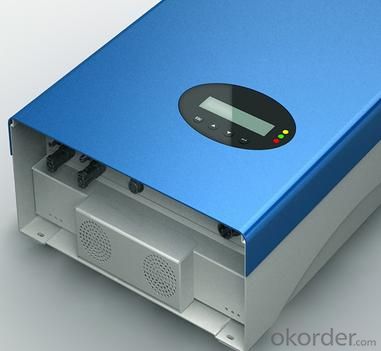
4, Detailed Specification
INPUT | |
Input voltage range | 185~265±5Vac |
OUTPUT | |
Output voltage range | 185~265±5Vac (AC mode) , 230Vac (DC mode) |
Output frequency (DC mode) | 50Hz (48~54Hz) or 60Hz(58~64Hz), same as AC(AC mode) 50Hz ±0.3Hz (DC mode) |
Wave form | Sine wave (DC Mode) |
Transfer time | 10ms. (Typical) |
BATTERY | |
Rated charging current (max.) | 45A |
Norminal DC input voltage | 12V |
Min. DC start voltage | 20V / 40V |
PHYSICAL | |
Unit dimension (mm) | 526*277*212 |
Master box dimension (mm) | 620*350*370 |
Net weight (1pc, kg) | 22.8 |
- Q: Can a solar energy system be installed in an area with high wind speeds?
- Yes, a solar energy system can be installed in an area with high wind speeds. However, certain considerations and precautions need to be taken into account during the installation process. It is important to choose solar panels that are designed to withstand strong winds and are properly anchored to withstand the force. Additionally, the support structures such as mounting racks or frames should be securely fastened to ensure stability. Professional installers with experience in high wind areas can design and install the system in a way that maximizes safety and efficiency. Furthermore, the orientation and angle of the solar panels may need to be adjusted to minimize wind resistance and potential damage. With proper planning and installation, solar energy systems can be successfully implemented in areas with high wind speeds, harnessing the power of the sun despite challenging environmental conditions.
- Q: Can solar energy systems be used in remote areas?
- Yes, solar energy systems can be used in remote areas. In fact, solar energy is particularly advantageous in remote locations as it provides a reliable and sustainable source of power without the need for extensive infrastructure or access to a traditional electricity grid. Solar panels can be installed in remote areas to generate electricity from the abundant sunlight, allowing for the provision of clean energy to power various applications such as lighting, water pumping, telecommunications, and even small-scale industrial activities. Additionally, advancements in solar technology and energy storage systems have made it possible to harness and store solar energy even in areas with limited sunlight, further expanding the potential for solar power in remote regions.
- Q: How do solar energy systems impact energy storage technologies?
- Solar energy systems have a significant impact on energy storage technologies by increasing the demand for efficient and scalable storage solutions. As solar power generation depends on sunlight availability, energy storage technologies help bridge the gap between peak solar production and peak energy demand, enabling a more reliable and flexible energy supply. This has spurred advancements in battery technology, grid-scale storage, and innovative storage solutions, ultimately driving the growth and integration of renewable energy sources into the grid.
- Q: Are there any noise or sound issues with solar energy systems?
- Solar energy systems do not produce any noise or sound issues as they operate silently.
- Q: Can solar energy systems be used for powering data centers or IT infrastructure?
- Yes, solar energy systems can definitely be used to power data centers or IT infrastructure. Solar energy is a renewable and sustainable source of power that can be harnessed through photovoltaic (PV) panels. By installing solar panels on the roofs or other suitable areas of a data center, companies can generate electricity from the sun and use it to power their IT infrastructure. This not only reduces reliance on traditional energy sources but also helps in minimizing carbon emissions and operating costs. Additionally, advancements in energy storage technologies allow for solar power to be used even during non-sunlight hours, ensuring uninterrupted power supply to data centers.
- Q: Can solar energy systems be leased or financed?
- Yes, solar energy systems can be leased or financed. Many companies offer lease or financing options for installing solar panels on residential or commercial properties. These options allow individuals or businesses to enjoy the benefits of solar energy without the high upfront costs of purchasing and installing the system.
- Q: Can solar energy systems be used in powering banks or financial institutions?
- Certainly, solar energy systems have the capability to power banks and financial institutions. Actually, numerous banks and financial institutions across the globe are adopting solar energy systems as a viable and economical solution for their power requirements. Solar energy systems comprise of photovoltaic (PV) panels that convert sunlight into electricity. These panels can be installed on the rooftops or open spaces surrounding banks and financial institutions. The electricity generated can then be utilized to power various operations within these institutions, such as lighting, air conditioning, computers, ATMs, and other electronic devices. There are several advantages to utilizing solar energy systems for banks and financial institutions. Firstly, they provide a consistent and uninterrupted source of electricity, reducing reliance on the conventional power grid. This ensures continuous operations and minimizes the risk of power outages, which is crucial for financial institutions that require constant access to their systems. Furthermore, the use of solar energy aids in reducing the carbon footprint of banks and financial institutions, contributing to environmental sustainability. By utilizing renewable energy, they can significantly decrease greenhouse gas emissions and combat climate change. This aligns with the growing focus on corporate social responsibility and sustainable practices among businesses. Additionally, solar energy systems offer long-term cost benefits. Although the initial installation cost may be higher compared to traditional energy sources, solar systems have low operating and maintenance costs. Over time, the savings on electricity bills can be substantial, enabling banks and financial institutions to allocate those funds towards other investments or initiatives. Moreover, the installation of solar panels can enhance the reputation and brand image of banks and financial institutions. By visibly demonstrating their commitment to renewable energy, they can attract environmentally conscious customers and investors who value sustainable practices. In conclusion, solar energy systems are highly suitable for powering banks and financial institutions, providing a reliable, sustainable, and cost-effective solution. By utilizing solar energy, these institutions can fulfill their power requirements while reducing their environmental impact and bolstering their reputation in the market.
- Q: Can solar energy systems be used in areas with limited access to solar energy publications and resources?
- Yes, solar energy systems can be used in areas with limited access to solar energy publications and resources. While access to information and resources can be helpful, it is not a prerequisite for utilizing solar energy systems. Basic knowledge and understanding of the technology, combined with technical expertise, can enable the installation and maintenance of solar energy systems. Additionally, local communities can seek support from experts, organizations, or government agencies to bridge the knowledge gap and ensure successful implementation of solar energy systems in such areas.
- Q: Can solar energy systems be used in disaster-stricken areas for emergency power supply?
- Yes, solar energy systems can be used in disaster-stricken areas for emergency power supply. Solar panels can generate electricity even in remote locations without access to the grid. They are a reliable and sustainable source of power that can be set up quickly to provide energy for essential services such as hospitals, communication systems, and emergency relief efforts. Solar power can help bring stability to disaster-stricken areas by providing a consistent and renewable source of electricity when traditional power infrastructure may be disrupted or unavailable.
- Q: Can a solar energy system be used in areas with limited sunlight?
- Indeed, the utilization of a solar energy system remains feasible in regions with limited sunlight. Although solar panels are most effective when directly exposed to sunlight, they are still capable of generating power in areas with limited sunlight. Even on cloudy days or during periods of low sunlight, solar panels can still produce electricity, albeit with reduced efficiency. Furthermore, the advancement of solar panel technology enables panels to capture and convert even diffuse sunlight, enabling their functionality in areas with limited direct sunlight. Additionally, solar energy systems can be tailored to incorporate energy storage solutions such as batteries. This enables the storage of excess energy generated during peak sunlight hours for later use during periods of limited sunlight. Consequently, solar energy remains a viable and sustainable solution for various regions worldwide, even those with limited sunlight.
Send your message to us
Solar Phocos AG MPS (45 – 80 A) Modular Power Switch High Quality for Solar Energy Systems in Alaska
- Loading Port:
- China Main Port
- Payment Terms:
- TT or LC
- Min Order Qty:
- -
- Supply Capability:
- 10000 unit/month
OKorder Service Pledge
OKorder Financial Service
Similar products
Hot products
Hot Searches
Related keywords
